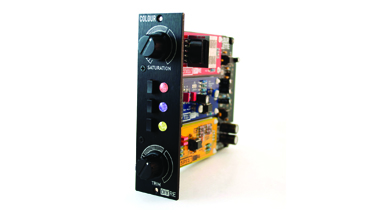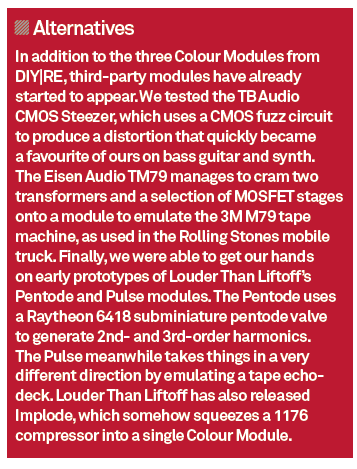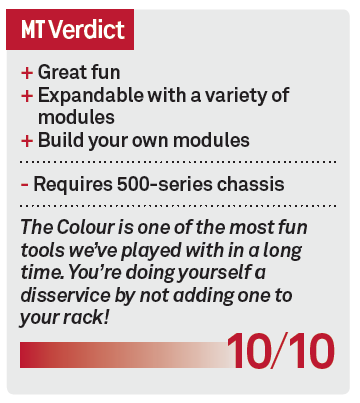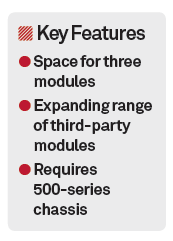DIY Recording Equipment Colour Review
DIY Recording Equipment has developed a new 500-series module to introduce some colour into your work. Mike Hillier brightens up… Details Price Colour Palette Kit, £75; JFT, £19; CTX, £36; 15IPS, £19 Contact Via website Web www.diyrecordingequipment.com Amazon.co.uk Widgets The DIY Recording Equipment blog is an invaluable source of information for anyone with even the slightest interest […]

DIY Recording Equipment has developed a new 500-series module to introduce some colour into your work. Mike Hillier brightens up…


Details
Price Colour Palette Kit, £75; JFT, £19; CTX, £36; 15IPS, £19
Contact Via website
Web www.diyrecordingequipment.com
The DIY Recording Equipment blog is an invaluable source of information for anyone with even the slightest interest in DIY audio equipment. Peterson Goodwyn’s blog houses information on nearly every kit we’ve come across. So when Peterson announced he was developing a new 500-series module to capture just the fun bits of some of his favourite circuits we were instantly intrigued.
In the spirit of the DIY community, Peterson detailed every stage on the blog, taking on board various community recommendations as it worked its way from inception to the eventual release.
The finished product is a DIY kit made of the Colour Palette – the 500-series module itself – which in turn houses three Colour Modules. We set to work building two Colour Palettes simultaneously, and were finished within a couple of hours.
The Palette itself is incredibly simple to build, with detailed instructions, and only gets a little fiddly when it comes to fitting the LEDs to the front panel – something we advise you take a little extra time on. Moving on to the modules we managed to build all six without any hiccup. We were given two each of the JFT, CTX and 15IPS modules, and the building couldn’t have been easier. This is basically Lego with a soldering iron.
The JFT uses a new old-stock 2SK170 JFET in a discreet Class A circuit to add a little low-order even harmonics to the signal, producing a similar distortion characteristic to a triode valve. The CTX uses a custom-wound Cinemag transformer to produce a softer, less marked saturation than the JFT, while the 15IPS uses a resonant high-pass filter and new old-stock germanium diodes to emulate the head-bump and soft-clipping of a tape machine running at 15ips.

Hitting the Tape
Our first foray into using the Colours was as a stereo pair in a mastering scenario. The track we had been sent was too brittle – we’d usually employ a tape emulator in this scenario to try and tame the transients a little, while also removing a little top-end – so we engaged the CTX and 15IPS modules.
The trick here is not to overdo it. We ended up dialling the saturation knob almost all the way down (we weren’t looking for an obvious distorted sound), just to smooth off an otherwise good mix.

The results were fantastic, and although it took a little time to set the levels evenly on each module – using tones and some very fine metering – the end result delivered everything we’d hoped. A switched input and output gain mod is available as a separate purchase, which swaps the two potentiometers on the front panel for switches, making it much easier to work with the Colours in stereo.
While the CTX and 15IPS modules are ready to go once built, the JFT module has a couple of variable resistors that need setting to bias the JFET and to set the output level. The biasing can be done by ear – send the module a variety of signals and set the bias to a distortion level you’re happy with, while the output is easily set using the meters.

However, to work in stereo we had to break out the FFT meters in order to bias the second JFT to produce a similar distortion characteristic to the first. Dialling this in also means either repeatedly taking the Colour out of your 500-series chassis – or as we did, using a third-party 500-series extension ribbon cable to place the Colour outside of the rack.
Once set, the JFT modules can be used for anything from very subtle colouration to quite an in-your-face sonic destruction. We got fantastic results on drums, bass and vocals using this module, and it’s sure to become a staple of our mix setup.
The Colour system is a fascinating example of what can be done with analogue electronics, and produces some great textures. If you have a 500-series with space for another module or two, this is a no-brainer.




